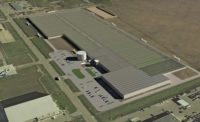
Pile driving is underway for construction of Canada's largest-ever nutrient-recovery facility, which will remove phosphorus from sewage solids in Edmonton, Alberta, and use it to make 10,000 kilograms per day of plant fertilizer. The facility will scale up by 20 times a demonstration plant installed in 2007.
"We are constructing a standard reinforced-concrete slab foundation on top of driven steel piles," says Gavin Post, project manager at Epcor Water Services, Edmonton. The firm and Ostara Nutrient Recovery Technologies, Vancouver, B.C., are partnering with contractor PCL Construction to install the Ostara nutrient-recovery reactor. The project, set to finish in October, will address provincial concerns related to stricter limits on potentially polluting nutrients to protect sensitive watersheds. Manitoba has set a new effluent-discharge limit for phosphorus, to take effect in 2016, and Alberta is considering new rules. The 600-sq-meter, 12-m-high facility will be built at the Clover Bar sewage-settling lagoons at Edmonton's Waste Management Center, where biosolids from the city's 310- million-liter-per-day Gold Bar wastewater treatment plant are discharged.
Installing the large nutrient reactor in the facility poses a challenge because it cannot be erected, shipped in one piece and installed, Post says. The reactor will be shipped from Oregon, where it is being fabricated in sections to be welded together on-site, he adds. "Crews will have to pour the foundation and then have the reactor temporarily assembled with tabs," Post says. He says the amount of fertilizer produced from phosphorus recovery will cover the cost of operating the facility.
"We're not interested in getting into the fertilizer business," Post says. "Ostara's nutrient-recovery technology will help reduce the amount of phosphorus we are discharging to the North Saskatchewan River at the Gold Bar plant." The reactor is sized to handle annual peaks in phosphorus levels and accommodate Edmonton's oil-and-gas-driven growth, Post says. Project cost was not disclosed.
Ostara's proprietary technology incorporates a fluidized-bed reactor and crystallization process to precipitate phosphorus and nitrogen out of dewatering recycle streams at treatment plants to prevent expensive struvite buildup in process equipment, says an Ostara spokesman.
To improve its design, Ostara reduced the reactor volume by 40% and added a "clean-in-place" system to reduce downtime and minimize component-cleaning requirements. Ostara says its fertilizer is virtually insoluble in water, lasts four times longer than conventional fertilizers and significantly reduces the risk of leaching or runoff into adjacent water bodies. Ostara built its first nutrient-recovery facility in Saskatoon, Saskatchewan, and has others in development in Calgary and in some Manitoba municipalities.



